The older learners get, the less likely they are to spend a significant part of the school day outside, saysJuno Hollyhock. but at what cost?
The importance of going outside at early years settings is largely taken for granted; indeed free flow is recommended good practice within the early years foundation stage curriculum. However, evidence shows that as children move into primary school they go outside significantly less than before during the day, and time outside appears to reduce further still once children are in the heady heights of secondary school.
The child who at seven years old was bouncing in the corridors with one arm in and one arm out of a coat, shoelaces untied, desperate to get outside in the rain becomes a teenager who would much rather lounge over the desks in the tutor base during the break regardless of the balmy weather outside. Harassed teachers end up shooing them out like so many chickens only to find that two minutes later they have found their way back in through the cracks and are now firmly superglued in position.
Some would argue that one of the reasons this happens is because as children grow older they don’t need to play so much. As young adults their requirements change and their chosen environment shifts as a consequence.
This may be true, but actually, of course, there is no reason why older children shouldn’t be able to enjoy themselves out of doors. The design brief for their space may be different but the benefits of fresh air and access to nature make it worth the effort. Nature in particular is known to have beneficial effects on mental health and a well designed outdoor space can improve health and wellbeing in older children.
And it’s not just a ‘nice thing to do’, either – wherever it happens, learning outside the classroom has been proven to raise attainment, improve behaviour and engage all children in their learning, especially those who are hard to motivate in the more traditional classroom environment. So, where might you be able to start?
In the school grounds
School grounds are an excellent way to begin engaging with learning outside the classroom.
They provide a useful and easily accessible stepping stone for teachers and students alike in getting used to being outside of the four walls and away from the interactive whiteboard or portable hand held devices (although these certainly have their place in the school grounds as more and more relevant outdoors apps are becoming available – look online for the latest educational app technology).
Well designed school grounds can offer a wealth of opportunities for making learning come alive in a real world context. Whether you are gathering natural materials for science experiments, investigating geometry and measurement for maths, or exploring local geography the application of academic subjects in a practical context embeds understanding and will help students to learn better. As with the educational brief for the building, the design for the school grounds should focus on the delivery of the curriculum as well as the provision of areas for recreation and relaxation.
The textbook on your doorstep
The next stage in getting learning outside is to investigate what is accessible within walking distance of your school. Many teachers do not live in the catchment area of the school where they teach, this can mean that they are unaware of what is on their doorstep. A little time spent walking around your local area can reveal some surprising resources, there is likely to be a wealth of local history ready to be discovered by learners. In fact, investigating, exploring and mapping the local area is a good curriculum activity in itself.
Walk-to buildings, attractions and green spaces often don’t have high cost admission fees. It may even be possible to arrange a visit to a local business or manufacturing plant linking in with a current curriculum topic. Often these types of visits can both make a curriculum subject come alive and help a student to have a sense of place and location in his or her own community. Older students will be beginning to consider further education and career choices and may be looking at the local industries as a source of future employment – this is also a good opportunity to talk about year ten work placements.
One of the often missed opportunities that may exist within walking distance of your school is the opportunity to visit archives, art and craft events, exhibitions and even stands in town halls and civic centres displaying information about proposed developments. This kind of excursion can be rich with curriculum links and again serve to engage students more closely with their local communities and what is happening there. It’s not just the end point that’s important – the walk itself will offer learning opportunities and as long as we consider every walk to be a learning walk then no time will be wasted travelling to and from your destination.
Going further afield
One of the challenges schools face when considering trips further afield or even overseas is the cost to the students and their families.
Some of the greatest benefits are felt by children who don’t have access to the financial resources for such trips and so it is worth remembering the role the Pupil Premium has to play.
A report by Ofsted suggests that the use of the premium to engage students in additional activities is widely recognised (How schools are using the Pupil Premium funding to raise achievement for disadvantaged pupils. Published: September 2012. Reference no: 120197.):
- A third of schools had used Pupil Premium funding to subsidise or pay for educational trips and residential visits.
- Schools also commonly said that they used the Pupil Premium to provide a wider range of curriculum opportunities and/or to ensure that money did not become a barrier to equality of access to an enhanced curriculum.
Remember that Pupil Premium Plus for children in the looked after system will rise to £1000 per pupil from April 2014 – and pupils will no longer have to have been in care for six months before they qualify, they will be entitled from day one.
When planning learning outside the classroom, it is important to think about the whole curriculum as the opportunities aren’t always obvious. Making the most of cross curricula learning during educational visits will help you to derive the most benefit from every experience, and may help you resolve teacher cover issues too.
Not everything always goes well on off-site trips and it is important to ensure that, as well as the required policies and procedures, you have in place both a sound sense of humour and a real determination to milk every experience for its richest learning potential. How you handle a difficult experience will be as much a learning experience for your students as the trip itself.
Case study: oasis academy lord’s hill
Oasis Academy Lord’s Hill is making great use of its school farm to benefit year 9 and 10 students and to help prepare them for their gcses.
The students visit the farm once a week for two years to take part in the Prince’s Trust XL programme, an ofqual recognised, externally moderated qualification. The XL curriculum lends itself well to be delivered outside in the environs of the farm. Students’ study revolves around practical activities for which some of the more academic disciplines such as maths become a necessary tool if they are going to get the most enjoyment out of the experience. For example, the students grow their own produce and market it on farm open days, they also learn how to cook the food that they have grown giving them a direct link to the requirements of the recently revised food technology element of the design and technology curriculum.
These curricular links are further developed with students being encouraged to explore issues such as food miles and food security alongside the importance of developing demand for locally produced, seasonal sustainable food sources.
To date the project has achieved a 100% pass rate for participating students, the Trust follows up with a more longitudinal study by text exploring student destinations and the links to further and higher education in related fields.
“I feel what we do at the farm by offering the Princes Trust XL programme shows how so much of the curriculum can be adapted to work in an outdoor setting,” comments Carley Sefton, centre manager at the Down to Earth Community Farm. “I wish schools could use us more, as I feel young people – especially those who struggle with mainstream schooling – gain so much from the experience. It’s not just about working with the animals, but everything from budgeting and organising community fun days to fencing and breeding programmes. I wish that outdoors education especially at secondary school, could be used more as an alternative. I know so many adults who would hate an office job, and yet despite this, we seem to think that sitting behind a desk all day is best for our children.”
The great outdoors:
Top tips
To get the very best out of any outside learning experience, there are some key things to remember:
If you are unsure about where to take your students for the best experience then look for the Learning Outside the Classroom Quality Badge – this will ensure that you don’t just get a high quality and safe experience but that it will also offer sound educational benefit.
Preparation in advance will ensure that there are no false expectations, discuss the trip with participants and their parents/carers and make sure that everyone understands what the aims are. If the plan is to team build and get to know one another then great but if you need some educational outcomes (as you certainly will if undertaking the trip in school time) then you need to be clear about this from the start. Don’t over plan – timetabling the trip is important but older students especially will appreciate the opportunity to relax, discuss their experiences and spend time with each other – and with you!
One of the best ways to ensure everyone is fully engaged is to make sure that staff on the trip are happy to get involved with the activities where it is safe and appropriate to do so. If you get involved and enjoy yourself then the chances are that the students will too.
Maximise the benefit after the trip by finding ways to share the experience with others and to keep the learning going; encourage students to commit to a follow up extended learning activity related to the trip.










The older learners get, the less likely they are to spend a significant part of the school day outside, saysJuno Hollyhock. but at what cost?